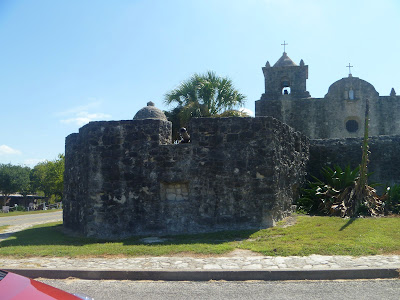 |
| Mission Nuestra Senora del Espiritu |
 |
| La Bahia Presidio |
A little further down the road we spotted signs for Mission Nuestra Senora del Espiritu. We were kinda hungry so we didn't stop to look around. However, after chatting with our uber friendly host at the cafe on the square, we decided to go back and do a little 'splorin. I'm so glad we did!
According to my friend Wikipedia, the mission and its companion presidio, or fort, were originally established by Spain in 1722, near LaSalle's Fort St. Louis, to convert local native Karankawa Indians to Christianity. After a couple of moves, they ended up amongst the Tamique and Aranama Indians, at their current locations, in 1749. Apparently the Karankawas were not very receptive to their efforts. The first structures were of logs and clay, but the stone and mortar complex was completed in 1758. The mission became the first large cattle ranch in Texas in about 1778, was secularized in 1830, and with most Indians having already left, the premium lands were acquired by local Mexican and American colonists, and the old misson's stones were removed and used for local construction. The remaining structure was used as a public school from 1848 to 1856, and gradually fell into ruin. The mission was restored by the CCC and WPA in 1930, and they even have a picture in the museum, of Eleanor Roosevelt there on the grounds to celebrate it becoming a state park. That's the short sweet version, but a whole lotta stuff happened in the interim. For one thing, it got tossed back and forth like a volley ball each time Texas came under a new flag (we've been under six, if you recall), with mucho blood being shed in the process. La Bahia later changed its name to Goliad, thought to be an anagram of Hidalgo (minus the silent H), the father of Mexico's independence from Spain.
 |
| The school building, back behind the main Mission structure. |
In October of 1835, a group of Texans attacked the presidio in the Battle of Goliad, and gained control of the fort. The first declaration of independence of the Republic of Texas was signed here on Dec. 20 of that year. The Texans held it until March of '36, when their garrison, under Colonel James Fannin, was defeated in the Battle of Coleto by Santa Anna. On Palm Sunday some 340 survivors from the fort were then marched out and executed in what was later called The Goliad Massacre -- a contributing factor, I believe, to those at the Alamo being determined to hold out to the bitter end.
Goliad is also the birthplace of a famous Mexican General, Ignacio Zaragoza, commander against the French army (another of our flags) in the Battle of Puebla -- now celebrated as Cinco de Mayo. Anyhoo, though I personally don't believe these missions did the Native Americans any favors (have you read A Thousand White Women?), it was still quite fascinating to walk around this bit of living history, and as far as beauty goes, well, I'll take Our Lady of the Spirit over a fancy cathedral any ol' day!



















No comments:
Post a Comment